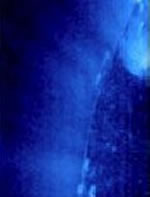
Image credit: SOHO
The ESA’s SOHO spacecraft has uncovered new details about the Sun’s solar wind which might overturn previously held theories about exactly how the wind is generated. Astronomers believed that the fast wind emanates from gaps between giant plumes found near the Sun’s polar regions. But the new theory, supported by data from SOHO is that it’s the plumes themselves which are hurling the particles of the fast wind into space. If this controversial theory turns out to be correct, it will clear up a big misunderstanding about the Sun.
We have known for 40 years that space weather affects the Earth, which is buffeted by a ‘wind’ from the Sun, but only now are we learning more about its precise origins. Solving the mystery of the solar wind has been a prime task for ESA’s SOHO spacecraft. Its latest findings, announced on 20 May 2003, may overturn previous ideas about the origin of the ‘fast’ solar wind, which occurs in most of the space around the Sun.
Earlier results from SOHO established that the gas of the fast wind leaks through magnetic barriers near the Sun’s visible surface. Straight, spoke-like features called plumes have also been seen rising from the solar atmosphere at the polar regions, where much of the fast wind comes from. According to previous ideas, the gas of the fast wind streams out in the gaps between the plumes.
“Not so,” says Alan Gabriel of the Institut d’Astrophysique Spatiale near Paris, France. Careful observations with SOHO now suggest that most of the fast wind leaves the Sun via the plumes themselves, which are denser than their surroundings. Gabriel and his team tracked gas rising at about 60 kilometres per second to a height of 250 000 kilometres above the Sun’s visible surface.
“If this controversial result is right, it will clear up a big misunderstanding,” says Bernhard Fleck, ESA’s Project Scientist for SOHO. “We need to know how the fast wind is subsequently accelerated to 750 kilometres per second. To find out, we’d better be looking in the right places.”
SOHO has also investigated the origin of a slower wind, half the speed of the fast wind, which comes from the Sun’s equatorial regions. The gas of the ‘slow’ wind leaks from triangular features called ‘helmets’, which are plainly protruding into the Sun’s atmosphere during a solar eclipse. Blasts of gas called ‘coronal mass ejections’ also contribute to the solar wind in the equatorial zone of the Sun.
The ESA/NASA Ulysses spacecraft has twice passed over the poles of the Sun and signalled the relative importance of these fast and slow winds. Its measurements show that the fast wind predominates in the heliosphere, which is a huge bubble blown into interstellar space by the Sun’s outpourings, and extending far beyond the outermost planets. In interplanetary space, the fast wind often collides with the slow wind. Like the mass ejections, the collisions create shock waves that agitate the Earth’s space environment.
The four satellites of ESA’s Cluster mission are now studying the interaction between the solar wind and our planet’s defences. The Earth’s magnetic field creates a bubble within the heliosphere, but it does not give us perfect protection from Sun’s storms. Ulysses, SOHO, and Cluster together provide an extraordinary overview of solar behaviour and its effects, both near and far in the Solar System.
Original Source: ESA News Release
